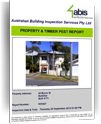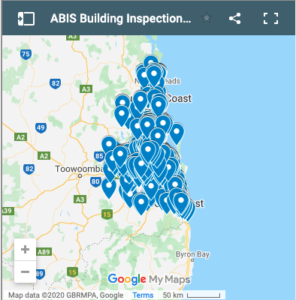Fungal Decay to Timber In Service
The reproductive spores of a mould fungus and the vegetative threads (mycelium) of a wood decay fungus, the latter usually white, if present in sufficient quantities, can be seen with the naked eye. However, vegetative growths of wood decay fungi may be cream, brown or black.
Wood Decay fungi prefer to grow where conditions of temperature and moisture content are not subject to fluctuation. For timer out of ground contact, such a stable situation is more often deep in the wood than on the surface. When the fungus has exhausted the available nutrient from the timber, new growth is supported by feeding on the older growth and so the fungus may grow on other surfaces away from the timber leaving very little visible evidence of fungal growth on the wood itself. Soft rot fungus for example.
Types of Fungi that Damage Timber
Not all fungi are capable of damaging the wood. Furthermore, not all fungi that can grow on or in wood are capable of damaging the wood structure itself. Very few species of fungi are to be found on or in timber. Mould fungi are found only on the outside of timber but do no damage. Sapstain fungi consume only the sugars from sapwood and cause no change in the relevant strength properties of the timber. A few species of wood decay fungi damage the cellulose component of timber only; other species damage both the lignin (plastic) and cellulose components.
Types of Decay in Australia
In general, decay of floorboards is caused by brown rot fungi, decay of window joinery by either brown rot or white rot fungi and decay of weatherboards often by white rot but sometimes by brown rot fungi. House stumps and fence posts decay from soft rot but may also have either brown or white rot. Serpula lacrymans (formerly Merulius lacrymans) is the world’s most destructive fungal decayer of timber in buildings. This brown rot fungus has an optimum temperature for growth at 20 degrees C (c.f. most wood decay fungi 25-28 degrees C).
Consequently, this fungus causes widespread damage in poorly ventilated subfloor areas in buildings in Melbourne where subfloor areas may be protected from the extremes of external temperatures. Probably as a result of high external temperatures, a species of Coniophora (also causing brown rot) is believed to be the commonest house timber decay fungus in Australia.
The term dry rot is a misnomer, dry timber will not rot. Also at the other end of the scale waterlogged timber will not rot. Wood decay fungi are extremely resilient and remain viable when colonies are disturbed, or when only part of a colony is poisoned or when dried out (some species can survive in a dry state for 9 years).
Moisture content values relating to timber in defined situations:
|
Oven dried and desiccated timber in the laboratory |
0% |
|
Equilibrium moisture content for timber in buildings, protected from weather |
|
|
Melbourne |
10-12 |
|
Melbourne, with air-conditioning |
8-14 |
|
Inland Queensland |
7-12 |
|
Coastal Queensland |
10-15 |
|
Lowest level at which decay can continue |
18-20 |
|
Lowest level at which corrosion of metal fastenings occur in wood |
18 |
|
Fibre saturation value, i.e. Level above which decay can commence |
30 |
|
Waterlogged wood |
150 or greater depending on timber species |
|
Moisture content of decaying wood |
20-120 |
|
Water as free water present in cell voids |
30-150 or greater |
|
Timber changes dimensionally |
|
|
In theory |
0-30 |
|
In practical situation |
7-30 |
|
Moisture meter gives accurate reading |
9-30 |
Moisture
Moisture content levels
To prevent decay starting in a susceptible timber, it is important to keep the moisture content below a certain critical value. The human senses are not suited to discriminating differences in moisture levels in materials, hence suitable instrumentation for determining the critical levels is essential.
The moisture content (MC) above which unprotected timber is considered to be decay susceptible is a conservative value of 18-20% MC. Together with a splinter test, the experienced investigator is able to determine the presence and extent of each of the following states of the timber:
- Sound and safe
- Sound but susceptible
- Affected and decaying (i.e. Active)
- Affected and decayed (i.e. either dormant or has finished rotting)
Moisture content of timber
Moisture content (%) of wood is the ratio of the mass of water contained in the wood to the mass of dry wood expressed as percent. Four combinations of moisture content of wood and relative humidity of airspace are listed with comments relating to conditions for fungal growth and subsequent wood decay. The presence of vegetation growth is not necessarily an indication of the presence of decay, however, the presence of a reproductive fruiting body of the fungus is usually associated with significant wood decay warranting replacement of timber (at least in part).
The moisture relationships of wood decaying fungi as related to growth on and in wood:
|
Scenario No. |
Moisture content of wood, percent |
Relative humidity of air space, percent |
Location and amount of fungal growth |
Condition of wood |
|
1 |
<20 |
<90 |
No growth on or in wood |
Not decaying |
|
2 |
20-120 |
<90 |
Growth mainly inside wood, surface mycelium flat and may not be too obvious |
Decaying |
|
3 |
30-120 |
>90 |
Growth inside wood, surface mycelium luxurious and growth very obvious |
Decaying |
|
4 |
>150 |
>90 |
Luxurious growth on surface, but with little growth within the wood |
Not decaying (because water logged) |
* For example, untreated joists/ bearers of a suspended wooden floor
NOTE: A comparison of 2 and 4 shows that the amount of growth visible on the wood surface may give no indication as to the amount of decay in that wood. It is for this reason that we characterize fungal decay simply according to the condition and appearance of the timber itself.
Moisture values for building timbers in Australia
The values for moisture content (%) for different building situations are listed. The additional values listed are a guide to determining the degree of risk for any timbers examined for moisture content (%).
Appearance of decay of timber
Decaying wood and decayed wood are visually quite different. Decaying wood contains sufficient moisture to retain its original shape and may have sufficient strength to withstand normal loads.
In contrast decayed wood is reduced both in moisture content and size as indicated by cracking either along or across the grain or by fibres coming apart in a stringy manner. Decayed wood will have undergone considerable strength reduction and in the case of floorboards could be eventually expected to fail under the load of humans or furniture.
Inspection for the decay in timber
Splinter test to determine strength loss. Although some practice is necessary, the splinter test is basically simple. A sharp instrument eg. A knife, with a locking blade, is more suitable than a chisel or screwdriver (the latter is usually too blunt to drive deep enough into the wood). Following is the procedure for testing:
- Insert the knife at right angles to the surface of the wood to a depth of 3 to 4 mm; this is best done with a single forceful jab, rather than a continuous push. If the blade has a wide tip, the latter should be inserted parallel to the direction of the wood grain.
- Bend the knife towards the face of the wood to pry out a splinter of wood. Sound wood will make a distinctive sound and produce a long splinter of wood with a jagged end without breaking across the top of the blade. Wood seriously affected by white rot fungus will fail along the grain, disintegrating into white and fibrous lengths. Brown rot and soft rot affected wood will break across the point of knife insertion, with no long splinters being produced and without a tearing sound. Badly decayed wood will often comer out in large chunks as the knife penetrates the timber. If the surface strength is affected, the splinter test is repeated, gradually penetrating deeper until sound wood is reached.
Until the inspector is fully experienced with the splinter test, splinters from suspected decay affected timbers should be compared with splinters similarly removed from timber (of the same species) in adjacent areas that are more likely to be sound (eg. The above ground areas around a post or stump that is being inspected for decay at or below ground line)
Moisture content
The moisture content of the timber should be checked in all areas perceived to be damp or where ventilation is considered to be inadequate.
The human senses are not adequately equipped to assess moisture. Electric moisture, meters give accurate readings for only certain specified materials, one example of which is timber. They are accurate between the point where there is a reasonable level of moisture in the walls of the wood cells (9%) to a level beyond which those cell walls will accept no more water themselves (i.e. the fibre saturation value of 30%). The safe value is clearly from 9 to 18 or 20 %MC. The possession of both a suitable moisture meter and the ability to interpret its readings is essential for any inspection of a building for the decay susceptibilities of its timber components.
In carrying out inspections the most critical determination is that of which timber is affected and decaying, because decay will most likely spread (unless sources of moisture are quickly removed). Affected and decayed may warrant timber replacement, but the rot there should not spread unless a new moisture source becomes available in that area. Sound but susceptible indicates a situation where decay is likely to eventually occur (again unless moisture removal is practiced) Sound and safe requires no further attention following this inspection.
Wikipedia Entry for Dry Rot




